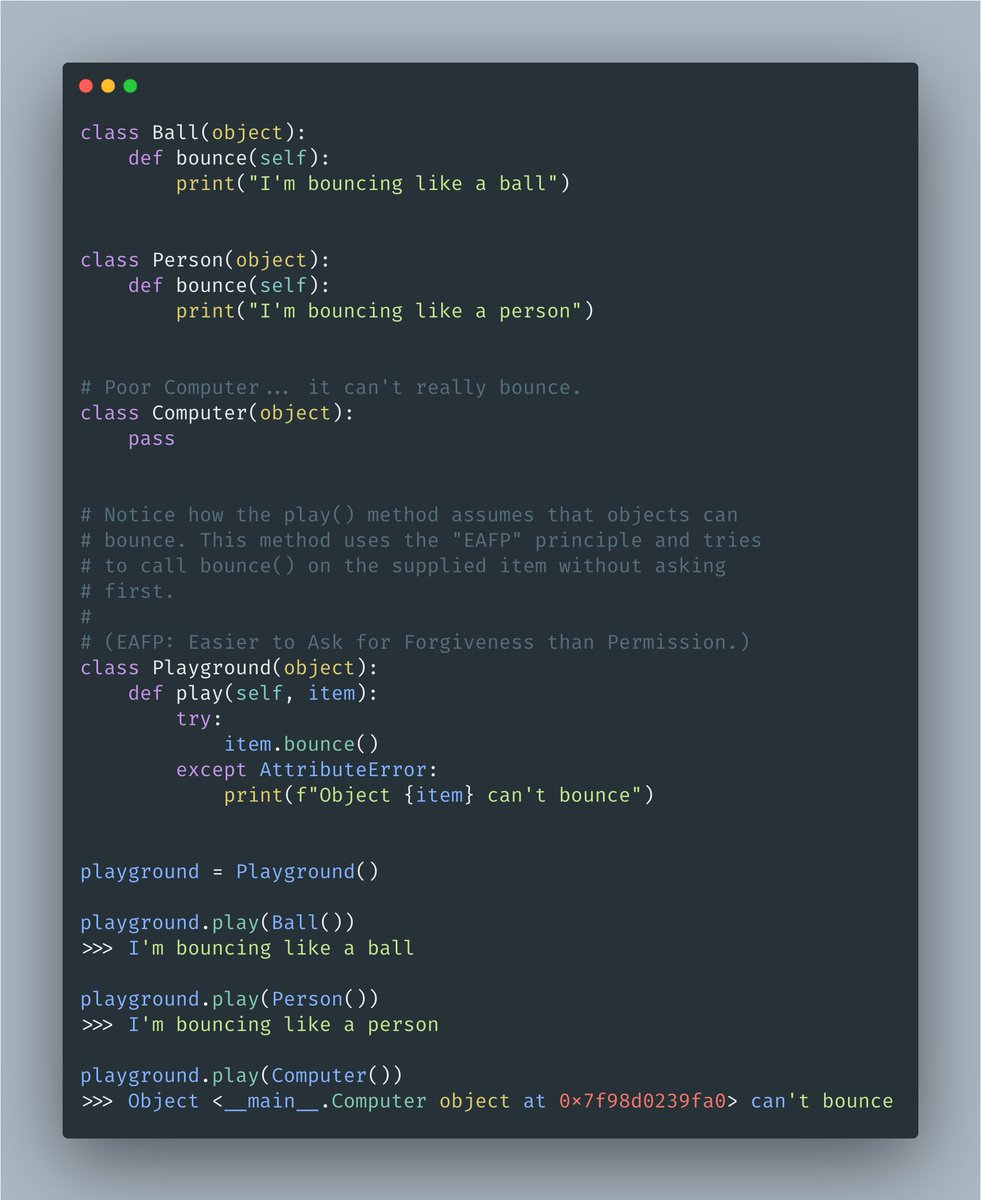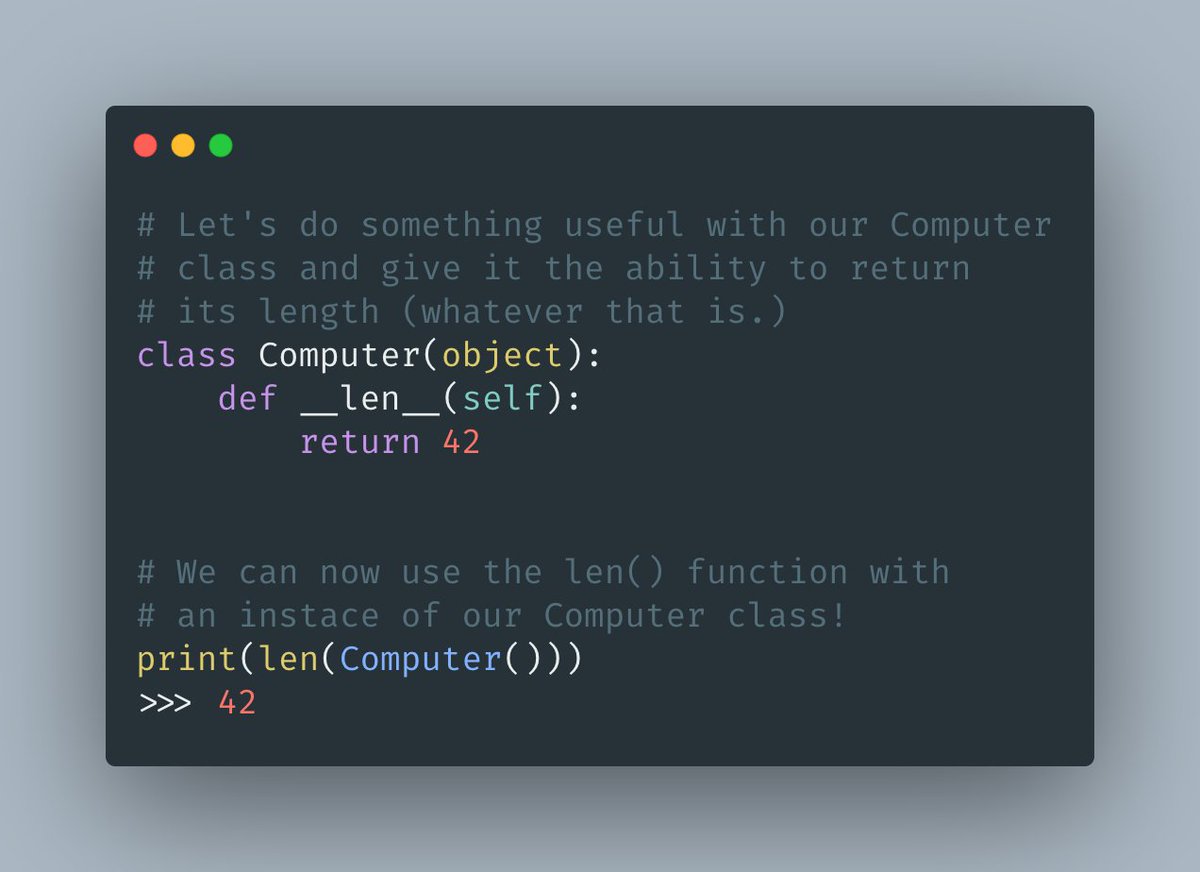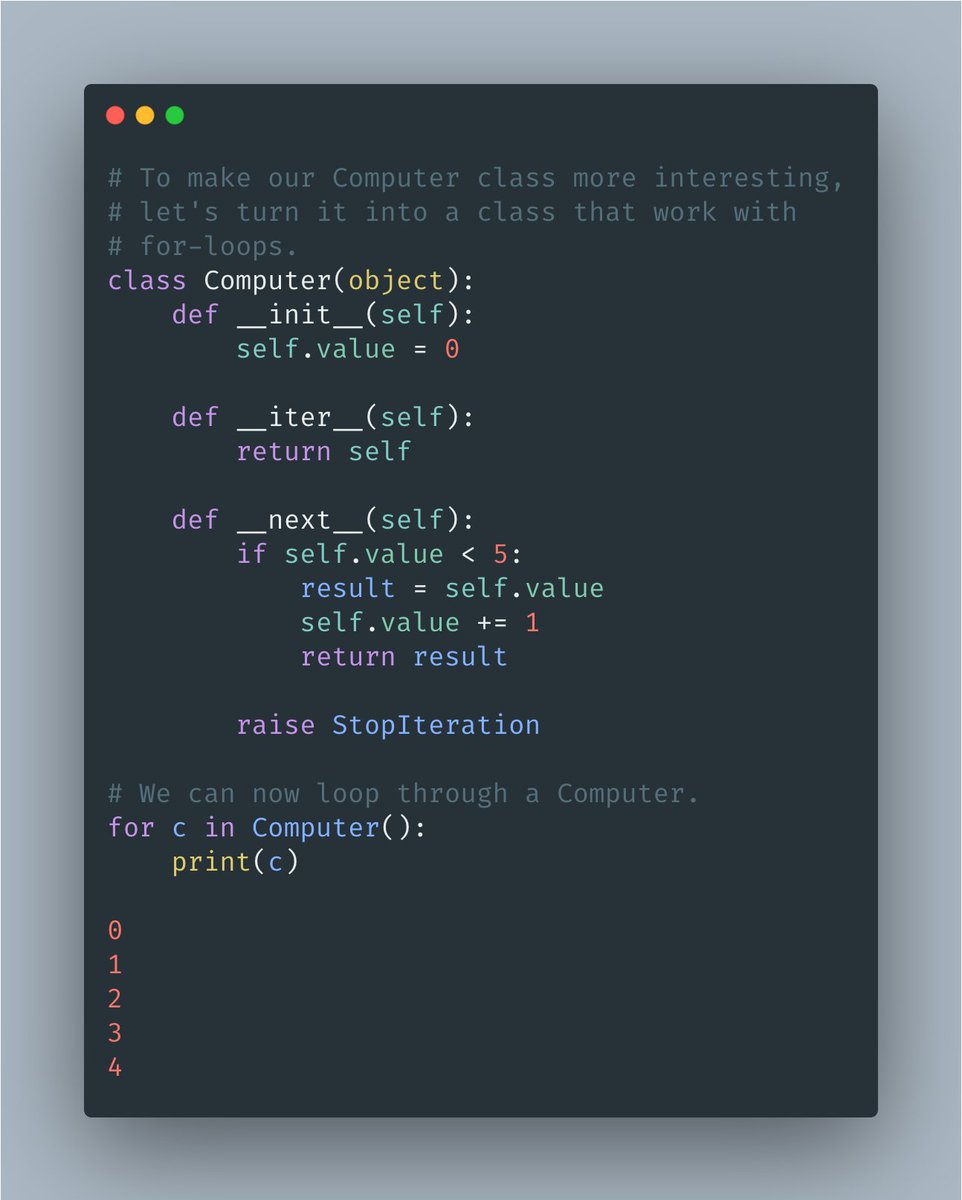When I heard about Duck Typing for the first time, I had to laugh.
But Python https://abs.twimg.com/emoji/v2/... draggable="false" alt="🐍" title="Schlange" aria-label="Emoji: Schlange"> has surprised me before, and this time was no exception.
https://abs.twimg.com/emoji/v2/... draggable="false" alt="🐍" title="Schlange" aria-label="Emoji: Schlange"> has surprised me before, and this time was no exception.
This is another short thread https://abs.twimg.com/emoji/v2/... draggable="false" alt="🧵" title="Thread" aria-label="Emoji: Thread"> that will change the way you write code.
https://abs.twimg.com/emoji/v2/... draggable="false" alt="🧵" title="Thread" aria-label="Emoji: Thread"> that will change the way you write code.
 https://abs.twimg.com/emoji/v2/... draggable="false" alt="👇" title="Rückhand Zeigefinger nach unten" aria-label="Emoji: Rückhand Zeigefinger nach unten">
https://abs.twimg.com/emoji/v2/... draggable="false" alt="👇" title="Rückhand Zeigefinger nach unten" aria-label="Emoji: Rückhand Zeigefinger nach unten">
But Python
This is another short thread
Here is the idea behind Duck Typing:
 https://abs.twimg.com/emoji/v2/... draggable="false" alt="▫️" title="Weißes kleines Quadrat" aria-label="Emoji: Weißes kleines Quadrat">If it looks like a duck, swims like a duck, and quacks like a duck, then it probably is a duck.
https://abs.twimg.com/emoji/v2/... draggable="false" alt="▫️" title="Weißes kleines Quadrat" aria-label="Emoji: Weißes kleines Quadrat">If it looks like a duck, swims like a duck, and quacks like a duck, then it probably is a duck.
Taking this to Python& #39;s world, the functionality of an object is more important than its type. If the object quacks, then it& #39;s a duck.
 https://abs.twimg.com/emoji/v2/... draggable="false" alt="👇" title="Rückhand Zeigefinger nach unten" aria-label="Emoji: Rückhand Zeigefinger nach unten">
https://abs.twimg.com/emoji/v2/... draggable="false" alt="👇" title="Rückhand Zeigefinger nach unten" aria-label="Emoji: Rückhand Zeigefinger nach unten">
Taking this to Python& #39;s world, the functionality of an object is more important than its type. If the object quacks, then it& #39;s a duck.
Duck Typing is possible in dynamic languages (Hello, JavaScript fans  https://abs.twimg.com/emoji/v2/... draggable="false" alt="👋" title="Waving hand" aria-label="Emoji: Waving hand">!)
https://abs.twimg.com/emoji/v2/... draggable="false" alt="👋" title="Waving hand" aria-label="Emoji: Waving hand">!)
Look at the attached example. Notice how "Playground" doesn& #39;t care about the specific type of the supplied item. Instead, it assumes that the item supports the bounce() method.
 https://abs.twimg.com/emoji/v2/... draggable="false" alt="👇" title="Rückhand Zeigefinger nach unten" aria-label="Emoji: Rückhand Zeigefinger nach unten">
https://abs.twimg.com/emoji/v2/... draggable="false" alt="👇" title="Rückhand Zeigefinger nach unten" aria-label="Emoji: Rückhand Zeigefinger nach unten">
Look at the attached example. Notice how "Playground" doesn& #39;t care about the specific type of the supplied item. Instead, it assumes that the item supports the bounce() method.
To make our Playground example work, we don& #39;t need to abuse from inheritance or implement interfaces.
Duck Typing makes it possible to use whatever we need to get the work done, and we don& #39;t have to worry about a complex hierarchy of types.
Let& #39;s see other examples.
 https://abs.twimg.com/emoji/v2/... draggable="false" alt="👇" title="Rückhand Zeigefinger nach unten" aria-label="Emoji: Rückhand Zeigefinger nach unten">
https://abs.twimg.com/emoji/v2/... draggable="false" alt="👇" title="Rückhand Zeigefinger nach unten" aria-label="Emoji: Rückhand Zeigefinger nach unten">
Duck Typing makes it possible to use whatever we need to get the work done, and we don& #39;t have to worry about a complex hierarchy of types.
Let& #39;s see other examples.
I& #39;m sure you are familiar with len(), the function that determines how many elements are in a list.
Thanks to Duck Typing, this function will work with any class that implements a __len__() method, regardless of its type.
 https://abs.twimg.com/emoji/v2/... draggable="false" alt="👇" title="Rückhand Zeigefinger nach unten" aria-label="Emoji: Rückhand Zeigefinger nach unten">
https://abs.twimg.com/emoji/v2/... draggable="false" alt="👇" title="Rückhand Zeigefinger nach unten" aria-label="Emoji: Rückhand Zeigefinger nach unten">
Thanks to Duck Typing, this function will work with any class that implements a __len__() method, regardless of its type.
The attached example uses __iter__() and __next__() to prepare our Computer class with everything it needs to work with the standard for-loop construct.
Again, no need to implement specific types. If it quacks, it& #39;s a duck.
 https://abs.twimg.com/emoji/v2/... draggable="false" alt="👇" title="Rückhand Zeigefinger nach unten" aria-label="Emoji: Rückhand Zeigefinger nach unten">
https://abs.twimg.com/emoji/v2/... draggable="false" alt="👇" title="Rückhand Zeigefinger nach unten" aria-label="Emoji: Rückhand Zeigefinger nach unten">
Again, no need to implement specific types. If it quacks, it& #39;s a duck.
One thing to notice:
Duck Typing is closely related to the "It& #39;s Easier to Ask for Forgiveness than Permission" (EAFP) principle.
In case you are curious, I wrote about EAFP just yesterday:
https://twitter.com/svpino/status/1315149223176929280?s=20
https://twitter.com/svpino/st... class="Emoji" style="height:16px;" src=" https://abs.twimg.com/emoji/v2/... draggable="false" alt="👇" title="Rückhand Zeigefinger nach unten" aria-label="Emoji: Rückhand Zeigefinger nach unten">
Duck Typing is closely related to the "It& #39;s Easier to Ask for Forgiveness than Permission" (EAFP) principle.
In case you are curious, I wrote about EAFP just yesterday:
https://twitter.com/svpino/status/1315149223176929280?s=20
What does this matter?
Dynamic-type advocates like myself love Duck Typing because it makes the code cleaner, explicit, and fosters reusability and flexibility without cluttering it with abstractions.
Static-type lovers have a different opinion.
But this is Python https://abs.twimg.com/emoji/v2/... draggable="false" alt="🐍" title="Schlange" aria-label="Emoji: Schlange">
https://abs.twimg.com/emoji/v2/... draggable="false" alt="🐍" title="Schlange" aria-label="Emoji: Schlange">
 https://abs.twimg.com/emoji/v2/... draggable="false" alt="🤷♂️" title="Achselzuckender Mann" aria-label="Emoji: Achselzuckender Mann">
https://abs.twimg.com/emoji/v2/... draggable="false" alt="🤷♂️" title="Achselzuckender Mann" aria-label="Emoji: Achselzuckender Mann">
Dynamic-type advocates like myself love Duck Typing because it makes the code cleaner, explicit, and fosters reusability and flexibility without cluttering it with abstractions.
Static-type lovers have a different opinion.
But this is Python

 Read on Twitter
Read on Twitter has surprised me before, and this time was no exception.This is another short thread https://abs.twimg.com/emoji/v2/... draggable="false" alt="🧵" title="Thread" aria-label="Emoji: Thread"> that will change the way you write code.https://abs.twimg.com/emoji/v2/... draggable="false" alt="👇" title="Rückhand Zeigefinger nach unten" aria-label="Emoji: Rückhand Zeigefinger nach unten">" title="When I heard about Duck Typing for the first time, I had to laugh.But Python https://abs.twimg.com/emoji/v2/... draggable="false" alt="🐍" title="Schlange" aria-label="Emoji: Schlange"> has surprised me before, and this time was no exception.This is another short thread https://abs.twimg.com/emoji/v2/... draggable="false" alt="🧵" title="Thread" aria-label="Emoji: Thread"> that will change the way you write code.https://abs.twimg.com/emoji/v2/... draggable="false" alt="👇" title="Rückhand Zeigefinger nach unten" aria-label="Emoji: Rückhand Zeigefinger nach unten">" class="img-responsive" style="max-width:100%;"/>
has surprised me before, and this time was no exception.This is another short thread https://abs.twimg.com/emoji/v2/... draggable="false" alt="🧵" title="Thread" aria-label="Emoji: Thread"> that will change the way you write code.https://abs.twimg.com/emoji/v2/... draggable="false" alt="👇" title="Rückhand Zeigefinger nach unten" aria-label="Emoji: Rückhand Zeigefinger nach unten">" title="When I heard about Duck Typing for the first time, I had to laugh.But Python https://abs.twimg.com/emoji/v2/... draggable="false" alt="🐍" title="Schlange" aria-label="Emoji: Schlange"> has surprised me before, and this time was no exception.This is another short thread https://abs.twimg.com/emoji/v2/... draggable="false" alt="🧵" title="Thread" aria-label="Emoji: Thread"> that will change the way you write code.https://abs.twimg.com/emoji/v2/... draggable="false" alt="👇" title="Rückhand Zeigefinger nach unten" aria-label="Emoji: Rückhand Zeigefinger nach unten">" class="img-responsive" style="max-width:100%;"/>
 If it looks like a duck, swims like a duck, and quacks like a duck, then it probably is a duck.Taking this to Python& #39;s world, the functionality of an object is more important than its type. If the object quacks, then it& #39;s a duck.https://abs.twimg.com/emoji/v2/... draggable="false" alt="👇" title="Rückhand Zeigefinger nach unten" aria-label="Emoji: Rückhand Zeigefinger nach unten">" title="Here is the idea behind Duck Typing:https://abs.twimg.com/emoji/v2/... draggable="false" alt="▫️" title="Weißes kleines Quadrat" aria-label="Emoji: Weißes kleines Quadrat">If it looks like a duck, swims like a duck, and quacks like a duck, then it probably is a duck.Taking this to Python& #39;s world, the functionality of an object is more important than its type. If the object quacks, then it& #39;s a duck.https://abs.twimg.com/emoji/v2/... draggable="false" alt="👇" title="Rückhand Zeigefinger nach unten" aria-label="Emoji: Rückhand Zeigefinger nach unten">" class="img-responsive" style="max-width:100%;"/>
If it looks like a duck, swims like a duck, and quacks like a duck, then it probably is a duck.Taking this to Python& #39;s world, the functionality of an object is more important than its type. If the object quacks, then it& #39;s a duck.https://abs.twimg.com/emoji/v2/... draggable="false" alt="👇" title="Rückhand Zeigefinger nach unten" aria-label="Emoji: Rückhand Zeigefinger nach unten">" title="Here is the idea behind Duck Typing:https://abs.twimg.com/emoji/v2/... draggable="false" alt="▫️" title="Weißes kleines Quadrat" aria-label="Emoji: Weißes kleines Quadrat">If it looks like a duck, swims like a duck, and quacks like a duck, then it probably is a duck.Taking this to Python& #39;s world, the functionality of an object is more important than its type. If the object quacks, then it& #39;s a duck.https://abs.twimg.com/emoji/v2/... draggable="false" alt="👇" title="Rückhand Zeigefinger nach unten" aria-label="Emoji: Rückhand Zeigefinger nach unten">" class="img-responsive" style="max-width:100%;"/>
 !)Look at the attached example. Notice how "Playground" doesn& #39;t care about the specific type of the supplied item. Instead, it assumes that the item supports the bounce() method.https://abs.twimg.com/emoji/v2/... draggable="false" alt="👇" title="Rückhand Zeigefinger nach unten" aria-label="Emoji: Rückhand Zeigefinger nach unten">" title="Duck Typing is possible in dynamic languages (Hello, JavaScript fans https://abs.twimg.com/emoji/v2/... draggable="false" alt="👋" title="Waving hand" aria-label="Emoji: Waving hand">!)Look at the attached example. Notice how "Playground" doesn& #39;t care about the specific type of the supplied item. Instead, it assumes that the item supports the bounce() method.https://abs.twimg.com/emoji/v2/... draggable="false" alt="👇" title="Rückhand Zeigefinger nach unten" aria-label="Emoji: Rückhand Zeigefinger nach unten">" class="img-responsive" style="max-width:100%;"/>
!)Look at the attached example. Notice how "Playground" doesn& #39;t care about the specific type of the supplied item. Instead, it assumes that the item supports the bounce() method.https://abs.twimg.com/emoji/v2/... draggable="false" alt="👇" title="Rückhand Zeigefinger nach unten" aria-label="Emoji: Rückhand Zeigefinger nach unten">" title="Duck Typing is possible in dynamic languages (Hello, JavaScript fans https://abs.twimg.com/emoji/v2/... draggable="false" alt="👋" title="Waving hand" aria-label="Emoji: Waving hand">!)Look at the attached example. Notice how "Playground" doesn& #39;t care about the specific type of the supplied item. Instead, it assumes that the item supports the bounce() method.https://abs.twimg.com/emoji/v2/... draggable="false" alt="👇" title="Rückhand Zeigefinger nach unten" aria-label="Emoji: Rückhand Zeigefinger nach unten">" class="img-responsive" style="max-width:100%;"/>
 " title="I& #39;m sure you are familiar with len(), the function that determines how many elements are in a list.Thanks to Duck Typing, this function will work with any class that implements a __len__() method, regardless of its type.https://abs.twimg.com/emoji/v2/... draggable="false" alt="👇" title="Rückhand Zeigefinger nach unten" aria-label="Emoji: Rückhand Zeigefinger nach unten">" class="img-responsive" style="max-width:100%;"/>
" title="I& #39;m sure you are familiar with len(), the function that determines how many elements are in a list.Thanks to Duck Typing, this function will work with any class that implements a __len__() method, regardless of its type.https://abs.twimg.com/emoji/v2/... draggable="false" alt="👇" title="Rückhand Zeigefinger nach unten" aria-label="Emoji: Rückhand Zeigefinger nach unten">" class="img-responsive" style="max-width:100%;"/>
 " title="The attached example uses __iter__() and __next__() to prepare our Computer class with everything it needs to work with the standard for-loop construct.Again, no need to implement specific types. If it quacks, it& #39;s a duck.https://abs.twimg.com/emoji/v2/... draggable="false" alt="👇" title="Rückhand Zeigefinger nach unten" aria-label="Emoji: Rückhand Zeigefinger nach unten">" class="img-responsive" style="max-width:100%;"/>
" title="The attached example uses __iter__() and __next__() to prepare our Computer class with everything it needs to work with the standard for-loop construct.Again, no need to implement specific types. If it quacks, it& #39;s a duck.https://abs.twimg.com/emoji/v2/... draggable="false" alt="👇" title="Rückhand Zeigefinger nach unten" aria-label="Emoji: Rückhand Zeigefinger nach unten">" class="img-responsive" style="max-width:100%;"/>


